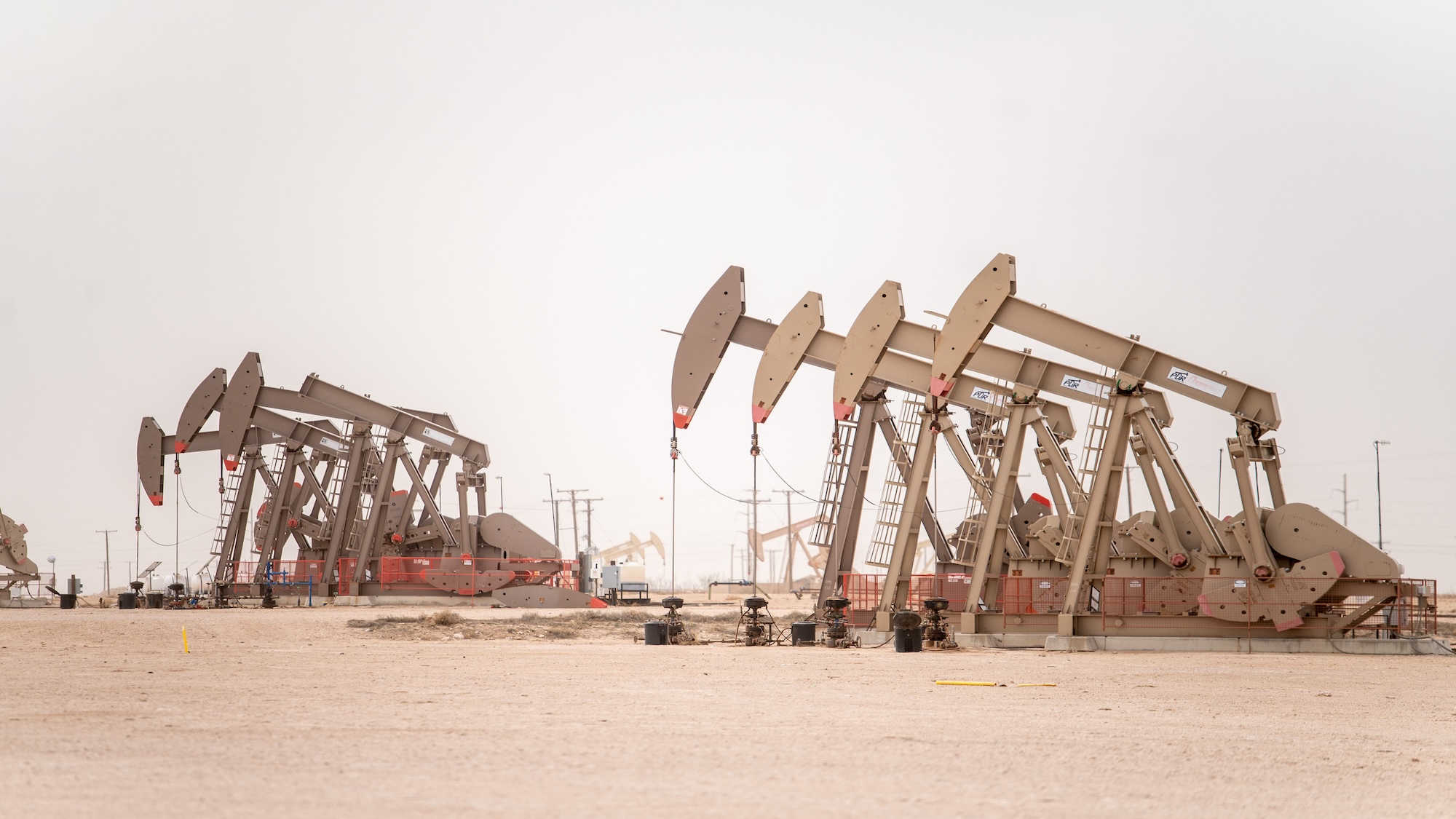Oil price posts two-year highs - but how long can it last?
Brent rose above $59 a barrel this week, its best third-quarter showing since 2004

Oil price: three reasons it is not recovering
22 September
You may have missed it, but oil prices rallied on Monday. Having started at around $48 a barrel Brent crude was at one point hovering near the $50 threshold, but the rally gave way in Asian trading overnight and the international benchmark is now falling back from whence it came.
The catalysts for the move up had been the fall in US inventories and the US interest rate hold, which weakened the dollar and kept prices low for traders in other currencies. So why haven't prices increased more strongly? Analysts identify three key reasons:
The Week
Escape your echo chamber. Get the facts behind the news, plus analysis from multiple perspectives.

Sign up for The Week's Free Newsletters
From our morning news briefing to a weekly Good News Newsletter, get the best of The Week delivered directly to your inbox.
From our morning news briefing to a weekly Good News Newsletter, get the best of The Week delivered directly to your inbox.
1. A weaker global economic outlook is raising fears that demand for oil will soften, says Reuters, leaving the market overstocked despite signs that production is finally starting to slow. A bearish message from the Fed in its rates commentary on China, the world's second largest oil consumer, has especially spooked traders across markets.
2. The existing overhang is massive, having built up over the course of a turf war between the Opec cartel and a booming US shale industry over the past year, and will take some time to clear. CNBC notes even the recent week-on-week fall in US stockpiles still leaves them up around a quarter on this time last year, with reports suggesting that reserves are at "record" levels and production is still outstripping supply.
Goldman Sachs, ANZ and other investment bank analysts have said it could take to the end of 2016 and a collapse in US output for supplies to begin to fall in a meaningful enough fashion for prices to return to profitable levels for most production.
3. Cutbacks are only happening in the US, with exports elsewhere – not least from Opec and its de facto leader Saudi Arabia – remaining high. In fact, the message from the cartel of late is that the stark predictions for US shale are a sign it is winning its wrestle for market share and will hold to its internecine strategy, despite pain for some of its own members. And of course, there is the likelihood of Iranian exports ramping up soon too.
A free daily email with the biggest news stories of the day – and the best features from TheWeek.com
All of this means that while traders are modestly reducing "short position" bets on falling prices on the US benchmark West Texas Intermediate, they continue to gamble on a down trend in Brent, Bloomberg notes. The differential between the two prices is also closing towards $2, down from an average 'spread' of $5 to $10 in recent years.[[{"type":"media","view_mode":"content_original","fid":"84694","attributes":{"class":"media-image"}}]]
Oil price: will $1.5tn of project cuts end slump?
21 September
How much production needs to be cut in order for the prolonged oil price slump to come to an end?
A new report from consultancy Wood Mackenzie suggests that as much as $1.5 trillion of new projects are now unlikely to go ahead with the oil price at its current low level. The Financial Times says this would amount to cuts of up to 30 per cent, implying that the effects of the past year's price slide "could resemble the savage downturn of the mid-1980s".
"Just half a dozen new projects will be approved this year and 10 or 11 in 2016," the report states, compared with an annual average of 50 to 60. North American production in particular will be hit, as flexible shale drilling has "reacted fastest to the market collapse". That suggests Opec has scored a victory of sorts by maintaining its own output to retain market share.
Cuts will be bad news for many in an industry that has already shed thousands of jobs, but for those remaining, they could signal a shift in the supply dynamic that could turn prices around. Reuters reports that following the publication of the latest figures both the US West Texas Intermediate and international Brent crude benchmarks rose in Asia's overnight trading session.
But the increases were modest at around 60 cents a barrel – and at around $45 for WTI and $48 for Brent much of the world's production will remain loss making.
The cost of a barrel will need to rise by $10 to $20 for fortunes to really change. That will require a much bigger shift in supply, which will not come until the end of 2016, based on recent projections of record output from non-US countries, including an increase from Iran if sanctions are soon lifted.
Investment Bank ANZ told Reuters it expects Brent to average $46 a barrel in 2016.
Oil price: stubborn Opec weighs down interest rate bounce
18 September
Like most dollar-traded commodities, oil was expected to rise if the Federal Reserve voted to hold interest rates on Thursday. The Fed held the rate - but the expected oil rise did not happen.
In the event, prices "wavered, then settled lower" after the Fed's decision and accompanying dovish commentary were published at 2pm local time, the Wall Street Journal notes.
West Texas Intermediate, the US benchmark, settled down 0.5 per cent at $46.90 a barrel, while the international benchmark Brent crude fell 1.3 per cent to a little more than $49.
This was despite the central bank’s decision weakening the dollar, which supports an oil market that is traded in dollars as it makes it "cheaper for buyers using foreign currencies", the WSJ says.
Like wider equity and commodity markets, part of the unexpectedly bearish sentiment was due to the reason offered for the hold, the slowdown in China, which could "limit oil demand".
There is also the reality that, with no compelling case to divert attention the market remains focused on the ongoing issue of oversupply, which shows no sign of abating.
Reuters reports the picture on production actually worsened on Thursday, after comments from Opec members that suggested the 12-nation cartel will hold firm to a policy of keeping supply high despite prices squeezing their economies, after recent market reports suggested it is winning the turf war with producers in the US and elsewhere.
Kuwait, a key member, said the oil market would "balance itself" but said this would take time, indicating support for the group's policy of defending market share. Reuters says ther sources at the organisation backed this view, "saying they expected oil prices to rise by no more than $5 a barrel per year" until 2020.
With prices currently rooted below $50, around $10-20 below levels that would make the majority of global production sufficiently profitable, this suggests a lot of pain ahead for the industry.
Oil price: Shell boss says recovery hard to predict
17 September
Oil prices rallied on Wednesday after the latest weekly report from US regulators showed a surprise fall in reserves, but the boss of oil major Shell has admitted a longer term recovery is hard to predict.
The Energy Information Agency reported that US inventories have fallen by 2.1 million barrels in the past week, the [1] Financial Times notes, a surprise reversal that brings to an end four weeks of consistent increases which had fuelled ongoing oversupply concerns.
This suggests a predicted drop in US production at a time of painfully low prices is already happening.
Benchmark West Texas Intermediate rose $3 to top $47 for the first time this week, while its international peer Brent crude was up $2 to rise above $50. Both are tapering down a little in Thursday morning trading and are sitting marginally below these thresholds.
Some argue the market at the moment is less concerned with short-term supply movements – not least because this does not change the fundamental picture that production still outstrips supply on a global basis – and are, like most markets this week, being driven by the prevailing view on the Federal Reserve's interest rate decision today.
In fact the oil rally yesterday was party driven by a fall in the dollar, after data showed a drop in inflation that could tip the balance to a Fed hold.
"When the currency weakens, commodities such as oil that are priced in dollars are more attractive for buyers who use other currencies," says the FT. If a hike is delayed again, the rally should gain momentum.
As to whether this could be the start of a major uplift from recent lows – The Times says some analysts "believe the market may have bottomed out last month" when Brent hit a six-year low close to $42 – this is much harder to anticipate.
Oil would need to recover $10-$20 a barrel to make production profitable on average.
Royal Dutch Shell boss Ben van Beurden told the BBC this is hard to predict and revealed his company is prepared for oil to be lower for longer.
Describing the "volatile" oil market as "inelastic", he said the price responds to "a few per cent of oversupply" and that price reductions would not boost demand sufficiently to turn the tide.
He added: "People don't drive to work twice because it's more economical to do so."
Oil price steadies as traders forecast rise
16 September
Oil prices rallied modestly from two-week lows on Tuesday, as traders forecast a more substantial bounce this week if the Federal Reserve reveals it has held interest rates at record lows when it concludes its meeting tomorrow.
International benchmark Brent crude rose to $47.80 a barrel, CNBC notes, and is again marginally higher on Wednesday morning in London at a little above $48. US benchmark West Texas Intermediary initially fell but later rallied, settling back above $45 after a dip earlier in the week. Both remain at relative lows and below profitable levels for much production.
One cause of the price movements – and intraday divergence – was the announcement by the Obama administration that it would oppose Republican plans to repeal a 40-year-old law banning exports of crude oil, initially designed to protect US energy interests during the Cold War.
Such a move would open up the market for US shale oil currently flooding the domestic market, but would pile further pressure on international oil producers and prices.
"But the impact was minimal and US prices rebounded quickly," the Wall Street Journal notes, explaining that even if the plans progress exports are "months away from starting up and shouldn't impact supply-and-demand for near-term trading".
It argues the main cause of the rise was technical: "After hitting a two-week low on Monday prices are apt to make a small bounce as traders consolidate positions."
A decision by the Fed not to raise rates – an increase would most likely boost the dollar and thus increase import costs – should make a further rise "inevitable", said Michael Nielsen, derivatives trader at Global Risk Management.
The more optimistic picture is being helped by mounting evidence that US production is falling, as market intelligence company Genscape predicted a fall in stockpiles this week and wider estimates suggest at least a levelling off to end four weeks of inventory building.
The US Energy Information Administration also forecast this week that US shale oil output would drop for a sixth straight month in October.
Overall, however, this will ease rather than reverse currency oversupply and price movements are expected to be limited. Reduced analyst forecasts in recent weeks suggest Brent should recover to around $50 to $55 in the coming months.
Has Opec cartel won the oil price war?
15 September
An oil turf war that has devastated global prices over the past year appears to be going the way of the Saudi Arabia-led cartel Opec, according to its own estimates which echo those of the global energy watchdog last week.
The 12-nation group's latest report predicted that supply from non-Opec countries would be around 58 million barrels per day next year, significantly lower than current projections.
Most of this decline, in line with the forecast by the International Energy Agency, is accounted for by a fall in US shale production, most of which makes a sizeable loss while oil is languishing in the $40-$50 a barrel range.
According to the Financial Times, the latest monthly report from the Vienna-based body suggests demand will rise from 93 million barrels a day to 94 million barrels a day next year, with the fall in global production both helping to address the current supply imbalance and boosting demand above Opec's "ceiling" of 30 million a day.
To protect its market share, Opec has been pumping around 32 million barrels a day this year.
But the report did little to mollify traders who remain concerned at global oversupply, indicating as it did that the group has little intention to reduce its own output to help ease price pressures as many had hoped.
Reuters notes international Brent crude fell below $46.50 on Monday and is trading below $47 a barrel again on Monday morning in London.
Opec's apparent victory has also come at a cost. The Daily Telegraph says while "the pain is being felt most acutely by higher cost producers in the developed world", including the North Sea, the aggressive supply strategy has "caused bitter divisions within the cartel" and especially provoked calls for an emergency meeting from the likes of Venezuela and Nigeria, which are heavily dependent on oil revenues and face bankruptcy.
"Even the richest and most steadfast members, such as Saudi Arabia, are being forced to revise their budgets and cut spending to adapt to lower prices," says the paper.
-
 Guess the Number: January 2026
Guess the Number: January 2026Puzzles The daily number puzzle from The Week
-
 The Week’s big New Year’s Day quiz 2026
The Week’s big New Year’s Day quiz 2026Quiz of the Year How much do you remember about 2025’s headlines? Put yourself to the test with our bumper quiz of the year
-
 Is tanking ruining sports?
Is tanking ruining sports?Today's Big Question The NBA and the NFL want teams to compete to win. What happens if they decide not to?
-
 How might the Israel-Hamas war affect the global economy?
How might the Israel-Hamas war affect the global economy?Today's Big Question Regional escalation could send oil prices and inflation sky-high, sparking a worldwide recession
-
 Recent mega-mergers could signal a turning point for the US oil industry
Recent mega-mergers could signal a turning point for the US oil industryTalking Point Both Chevron and Exxon have recently spent billions to acquire smaller oil companies
-
 Has Saudi Arabia lost control of oil prices?
Has Saudi Arabia lost control of oil prices?Today's Big Question Kingdom goes it alone to cut production, risking tension with US and reigniting cooling inflation in Europe
-
 US angered by Opec+ oil cut
US angered by Opec+ oil cutSpeed Read Energy prices to rise further as producers slash supply by two million barrels a day
-
 Global oil demand forecast lowered for 2020 and 2021
Global oil demand forecast lowered for 2020 and 2021Speed Read IEA report says jet fuel demand remains the major source of weakness
-
 Are US-Iran tensions flaring again?
Are US-Iran tensions flaring again?In Depth Trump threatens military action over Twitter
-
 Can a deal be struck to raise oil prices?
Can a deal be struck to raise oil prices?In Depth Opec+ will convene today over video link in a bid to boost crude
-
 What do negative oil prices mean?
What do negative oil prices mean?In Depth Perfect storm of oversupply and storage shortages sees producers paying to get rid of US crude